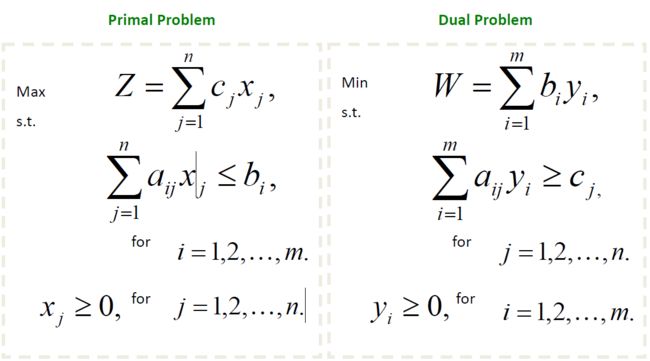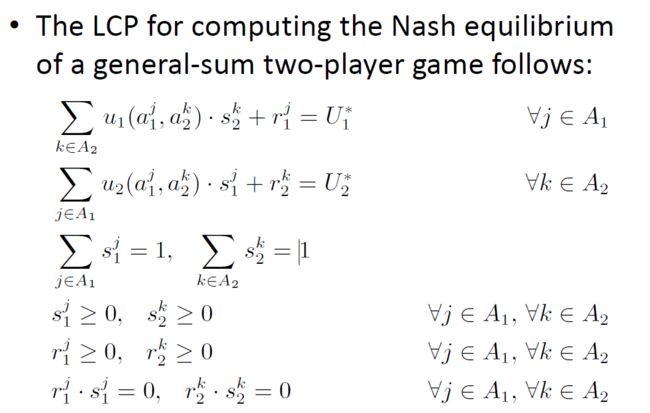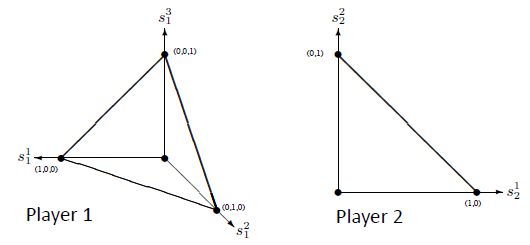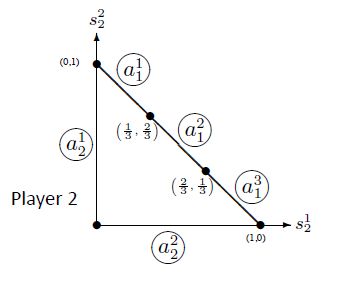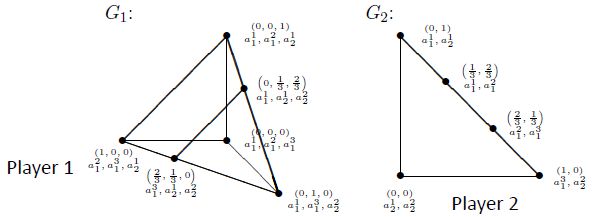多智能体强化学习与博弈论-博弈论基础3
多智能体强化学习与博弈论-博弈论基础3
之前主要介绍了如何判断博弈中是否到达了纳什均衡,在这篇文章中将主要介绍如何计算纳什均衡。
本文主要介绍下列几种情况下的纳什均衡
-
两个智能体,每个智能体有两个动作
-
两个智能体,每个智能体有多个动作,零和博弈
-
非零和,每个智能体有多动作
零和博弈
Minimax Theoram:For every two-person, zero-sum game with finitely many pure strategies, there exists a mixed strategy for each player and a value V such that:
- Given player 2’s strategy, the best possible payoff for player 1 is V
- Given player 1’s strategy, the best possible payoff for player 2 is –V.
当智能体的动作有多个时,我们可以借助线性规划来帮助我们求解。
以下面这个情况为例(player1为row player, player2为column player,以两个动作为例)
设player1的策略为
-
V(“Morality”)=-3x1+2x2
-
V(“Tax-cuts”)=x1-x2
player2的最优收益为max(-3x1+2x2,x1-x2),player1的最优收益为-max(-3x1+2x2,x1-x2)=min(3x1 − 2x2, −x1 + x2)。
我们可以使用下面的这个线性规划来求解player1的最优策略。
同理我们也可以使用下面的这个线性规划来求解player2的最优策略。
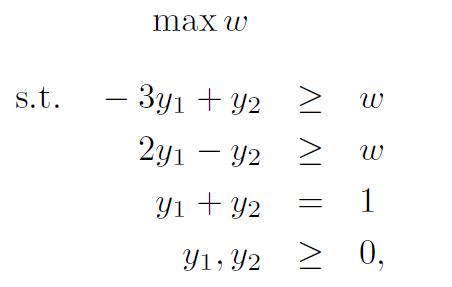
线性规划中的对偶性
每一个线性规划问题都有一个对应的线性规划问题被称为对偶问题,对偶问题对于原问题的求解在很多时候都有着重要的作用。原问题和对偶问题的关系如下图所示。
强对偶性:由前面我们可以知道
y A x ≤ y b y A x ≥ c x yAx\leq yb \\ yAx\geq cx yAx≤ybyAx≥cx
可以推出
c x ≤ y A x ≤ y b cx\leq yAx\leq yb cx≤yAx≤yb
当满足
c x = y A x = y b cx=yAx=yb cx=yAx=yb
则称原问题和对偶问题的关系为强对偶。
原问题对偶的对偶为原问题。
非零和博弈
当我们面对的问题不是零和博弈问题时,往往不能使用线性规划来求解,而是将问题建模成线性互补问题(linear complementarity problem (LCP)).对于这里的线性互补问题,它是没有目标函数的,整个问题是一个可行性问题。
其中 r r r为松弛变量, s i j s_i^j sij为player i选择动作j的概率。最后一行的约束称作complementarity condition。这个约束意味着当 s i j s_i^j sij>0时 r i j = 0 r_i^j=0 rij=0。
The Lemke-Howson algorithm
Lemke-Howson algorithm是一个非常知名的用于解决LCP问题的算法,它利用了图论的思想。
假设有下面这个问题
我们可以使用图来表示player的策略,不同坐标轴代表不同的策略。
接着我们需要给player的动作打标签L( s i j s^j_i sij ) ⊆ A1 ∪ A2 。
Mixed strategy si for player i is labeled as follows:
-
with each of player i’s actions a i j a^j_i aij that is not in the support of s i s_i si(with zero prob. of choosing it) and
-
with each of player −i’s actions a − i j a^j_{−i} a−ij that is a best response by player −i to s i s_i si.
当L(s1) ∪ L(s2) = A1 ∪ A2时我们称这两个策略达到了纳什均衡。
以player2为例,我们可以给player2图像上的边打标签。 a 2 1 a^1_2 a21代表player2选择动作1的概率为0, a 1 2 a^2_1 a12代表player1选择2是针对player2最好的策略。(1/3,2/3)这个点代表如果player2以1/3的概率使用动作1,2/3的概率使用动作2,那么对于player1而言使用动作1和动作2取得的收益都是相同的,以此类推。
我们可以给每个点标号
在这个例子中总共存在三个纳什均衡
[(0, 0, 1), (1, 0)], [(0, 1/3, 2/3) , (2/3, 1/30)] , and [(2/3, 1/3,0) , (1/3, 2/3)]
参考:
汪军老师UCL多智能体强化学习网课


